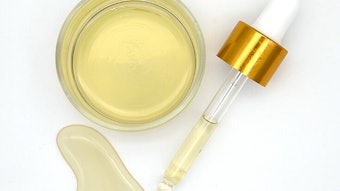Advanced materials that are capable of undergoing physical or chemical changes in response to external stimuli have great potential in the fields of medicine, biotechnology, electronics and personal care.1–3 Commonly referred to as “smart polymers,” these materials can respond to temperature, pH, light, sound and mechanical forces, among others.
A variety of smart polymers exist for applications including self-healing materials, tissue engineering, medical imaging and data storage. Liquid crystalline displays are a prime example of an optically responsive material that has led to an immensely profitable industry; however, self-assembling micelles and gels are the most relevant to personal care, having potential for molecular encapsulation and triggered release.
Smart polymers can be engineered to contain reactive molecules, commonly dubbed “molecular switches,” that respond to external stimuli and cause systemic changes to the polymer structure. For example, chemical or electronic changes disrupt the polymeric macromolecular structure and trigger the subsequent release of entrapped compounds (see Figure 1).
Such changes can be engineered to be reversible or irreversible, depending on the end use. The specificity of a molecular switch to a single stimulus is critical for controlled release, although multi-triggered systems capable of responding to systematic stimuli are being developed for advanced applications. Herein the authors describe several stimuli-responsive materials that have potential applications for personal care and related biomedical fields.
Light-responsive Materials
The design and fabrication of photo-responsive polymers can be accomplished by incorporating a photosensitive molecular switch into the backbone of a polymer. These polymers can be engineered to behave as macromolecular hosts that release small molecular guests in response to sunlight irradiation.4 Sunlight provides the stimuli that causes small molecules along the polymer backbone to “switch,” resulting in the disruption of the macro- molecular framework and subsequent release of the guest.
For the personal care industry, photo-responsive polymeric hosts have wide-reaching applications, and can be synthesized to release their molecular payloads in response to varying intensities of sunlight. Molecular payloads may include UV absorbers, tanning agents or moisturizing agents to hydrate dry skin. A photo-responsive polymer that gradually releases a UV absorber could ensure the wearer continuous protection from sunlight, and circumvent the need for constant re-application of sunscreen.
One interesting example uses spiropyran, a small-molecule organic compound that is neutral under irradiation with visible light but becomes charged upon exposure to UV (see Figure 2). Matyjaszewski and co- workers have shown that amphiphilic block polymers containing spiropyran molecules are useful to reversibly encapsulate drug molecules for cancer treatment.5
In the absence of UV light, the polymer self-assembles into a spherical micelle, encapsulating the therapeutic agent. Exposure to UV light then causes the neutral spiropyran molecules to become charged, disrupting the integrity of the micelle and causing rapid release of the drug. When the UV source is removed, the spiropyran molecules return to their neutral state, and the polymer reversibly self-assembles into micelles. Moreover, spiropyran is highly fluorescent in its charged form, allowing for simultaneous delivery of the payload and imaging of the target site.
Temperature-responsive Materials
Thermally induced phase transitions can cause swelling and the collapse of a polymer network, which have found applications in drug delivery and tissue engineering. Poly(N-isopropylacrylamide), or pNIPAM, and its derivatives are the major components of thermally responsive materials for biological applications. Polymer networks and gels composed of pNIPAM swell substantially when cooled below 32°C—i.e., pNIPAM’s lower critical solution temperature (LCST)—and reversibly shrink above its LCST. This reversible property occurs near human body temperature, making it especially appealing for dermatological applications. Other thermally responsive materials have found use in lithography and data storage, however their LCST is outside the “sweet spot” required for biological applications.
Recently, PNIPAM-based micron-sized hydrogels (microgels) were used in vitro as a controlled delivery system for cationic anti-inflammatory peptides.6 Peptides loaded in PNIPAM-based microgels were shielded from being recognized and degraded by human serum. These hydrogels also demonstrated that the rate of payload release was affected by temperature; cooling the microgel to 4°C caused swelling of the polymer network, thus the peptides were released in a few hours. However, at 37°C, release of the peptide payload occurred over a week’s time due to the collapsed state of the PNIPAM polymer, which restricted the release of the peptide payload (see Figure 3).
pH-responsive Materials
The physiological environment also provides a unique setting for the design of pH-responsive materials. Molecular payloads can be selectively delivered to targets by exploiting subtle differences in pH. As an example, a pH-responsive vitamin-C hydrogel system was recently developed by Lee et al.7 Hydrogel microparticles were synthesized by dispersion photopolymerization and designed to undergo structural changes at skin pH.
Upon delivery to the skin, the microparticles are deprotonated and become swollen, releasing vitamin C into the surrounding environment. These microparticles can be rationally designed to carry a wide number of skin-beneficial ingredients such as emollients, anti-aging agents and luminescents. Such pH-responsive systems provide an interesting mechanism for the cosmetic chemist to deliver molecular payloads to the epidermis.
Conclusion
Though these synthetic systems are rudimentary compared with the responsive mechanisms found in nature, their complexities are rapidly increasing and furthering the development of highly selective and sensitive materials. Multi-triggered systems capable of responding to systematic stimuli for the release of therapeutic agents in vivo are exciting frontiers in bioengineering, materials science and personal care; although caveats exist such as the need for stringent preparation methods, including controlled lighting, pH or temperature, depending on the stimuli-responsive polymer used.
References
1. J Hu and S Liu, Responsive polymers for detection and sensing applications: Current status and future developments, Macromolecules 43 8315–833 (2010)
2. M Natali and S Giordani, Molecular switches as photocontrollable ‘‘smart’’ receptors, Chem Soc Rev 41 4010–4029 (2012)
3. D Roy, JN Cambre and BS Sumerlin, Future perspectives and recent advances in stimuli-responsive materials, Prog Polym Sci, 35 278–301 (2010)
4. J Schumers, C Fustin and J Gohy, Light-responsive block copolymers, Macromol Rapid Commun 31 1588–1607 (2010)
5. H Lee, W Wu, JK Oh, L Mueller, G Sherwood, L Peteanu, T Kowalewski and K Matyjaszewski, Light-Induced reversible formation of polymeric micelles, Angew Chem Int Ed 46 2453–2457 (2007)
6. RL Bartlett, II; M R Medow; A Panitch and B Seal, Hemocompatible poly(NIPAm-MBA-AMPS) colloidal nanoparticles as carriers of anti- inflammatory cell penetrating peptides, Biomacromolecules 13 1204−1211 (2012)
7. E Lee, K Kim, M Choi, Y Lee, J Park and B Kim, Development of smart delivery system for ascorbic acid using pH-responsive P(MAA-co-EGMA) hydrogel microparticles, Drug Delivery 17 573-590 (2010)










